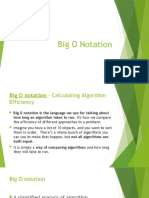Dynamic Programming 7
Uploaded by
Arvin HipolitoDynamic Programming 7
Uploaded by
Arvin HipolitoSequence alignment[edit]
In genetics, sequence alignment is an important application where dynamic programming is
essential.[11] Typically, the problem consists of transforming one sequence into another using edit
operations that replace, insert, or remove an element. Each operation has an associated cost, and
the goal is to find the sequence of edits with the lowest total cost.
The problem can be stated naturally as a recursion, a sequence A is optimally edited into a
sequence B by either:
1. inserting the first character of B, and performing an optimal alignment of A and the tail of B
2. deleting the first character of A, and performing the optimal alignment of the tail of A and B
3. replacing the first character of A with the first character of B, and performing optimal
alignments of the tails of A and B.
The partial alignments can be tabulated in a matrix, where cell (i,j) contains the cost of the optimal
alignment of A[1..i] to B[1..j]. The cost in cell (i,j) can be calculated by adding the cost of the relevant
operations to the cost of its neighboring cells, and selecting the optimum.
Different variants exist, see Smith–Waterman algorithm and Needleman–Wunsch algorithm.
You might also like
- Optimization of A Classical Algorithm For The Alignment of Genomic Sequences With Artificial Bee ColonyNo ratings yetOptimization of A Classical Algorithm For The Alignment of Genomic Sequences With Artificial Bee Colony7 pages
- Sequence Comparison: Motivation: Finding Similarity Between Sequences Is Important For Many Biological QuestionsNo ratings yetSequence Comparison: Motivation: Finding Similarity Between Sequences Is Important For Many Biological Questions47 pages
- Pattern Matching Techniques and Their Applications To Computational Molecular Biology - A ReviewNo ratings yetPattern Matching Techniques and Their Applications To Computational Molecular Biology - A Review8 pages
- Sequence Alignment: Lecture 2, Thursday April 3, 2003No ratings yetSequence Alignment: Lecture 2, Thursday April 3, 200339 pages
- Dynamic Programming Methods in Pairwise AlignmentNo ratings yetDynamic Programming Methods in Pairwise Alignment41 pages
- Alignment Methods: Introduction To Global and Local Sequence Alignment MethodsNo ratings yetAlignment Methods: Introduction To Global and Local Sequence Alignment Methods57 pages
- Bio Medical Tics - Sequence Analysis - Alignment - 2011No ratings yetBio Medical Tics - Sequence Analysis - Alignment - 201196 pages
- Sequence Comparison and Alignment: Bioinformatics #4 IPB UniversityNo ratings yetSequence Comparison and Alignment: Bioinformatics #4 IPB University37 pages
- New Sequence Alignment Algorithm Using Ai Rules and Dynamic SeedsNo ratings yetNew Sequence Alignment Algorithm Using Ai Rules and Dynamic Seeds14 pages
- Sequence Alignment Methods and AlgorithmsNo ratings yetSequence Alignment Methods and Algorithms37 pages
- Lecture 4.1 and 4.2 Sequence Alignment (Global and Local)No ratings yetLecture 4.1 and 4.2 Sequence Alignment (Global and Local)14 pages
- Lecture 5: Multiple Sequence Alignment: Introduction To Computational BiologyNo ratings yetLecture 5: Multiple Sequence Alignment: Introduction To Computational Biology34 pages
- Unit - Ii Sequence Analysis: Pair-Wise Sequence ComparisonNo ratings yetUnit - Ii Sequence Analysis: Pair-Wise Sequence Comparison17 pages
- Sequence Alignment: Lecture 2, Thursday April 3, 2003No ratings yetSequence Alignment: Lecture 2, Thursday April 3, 200338 pages
- The Needleman Wunsch Algorithm For Sequence AlignmentNo ratings yetThe Needleman Wunsch Algorithm For Sequence Alignment46 pages
- CSC 344 - Algorithms and Complexity: Lecture #3 - Internal SortingNo ratings yetCSC 344 - Algorithms and Complexity: Lecture #3 - Internal Sorting33 pages
- Mathematical Optimization: Recursive Bellman EquationNo ratings yetMathematical Optimization: Recursive Bellman Equation1 page
- CSC 344 - Algorithms and Complexity: Lecture #5 - SearchingNo ratings yetCSC 344 - Algorithms and Complexity: Lecture #5 - Searching31 pages
- Dynamic Programming Is Both A: Mathematical Optimization Richard Bellman Aerospace Engineering Economics RecursiveNo ratings yetDynamic Programming Is Both A: Mathematical Optimization Richard Bellman Aerospace Engineering Economics Recursive1 page
- 19 Century Philippines As Rizal's Context: The Life and Works of RizalNo ratings yet19 Century Philippines As Rizal's Context: The Life and Works of Rizal10 pages
- Republic Act 1425: The Life and Works of RizalNo ratings yetRepublic Act 1425: The Life and Works of Rizal6 pages









































































